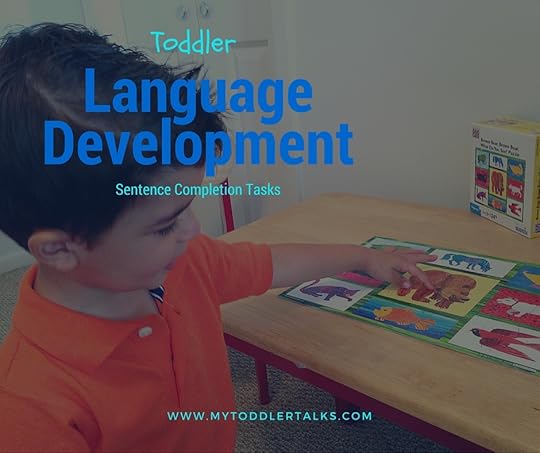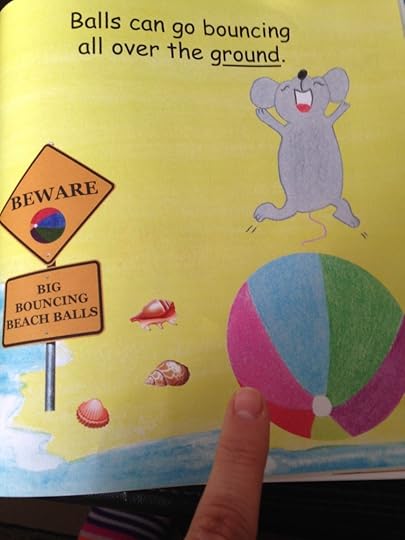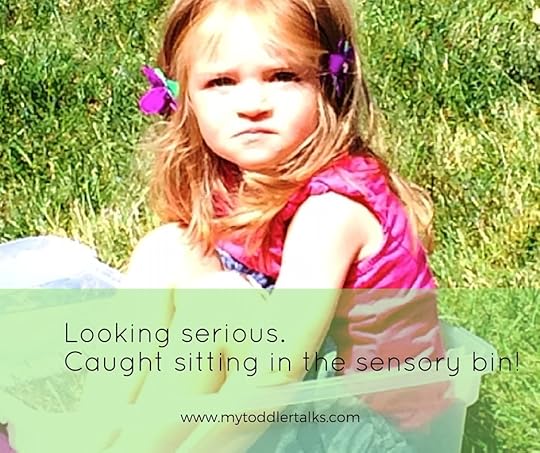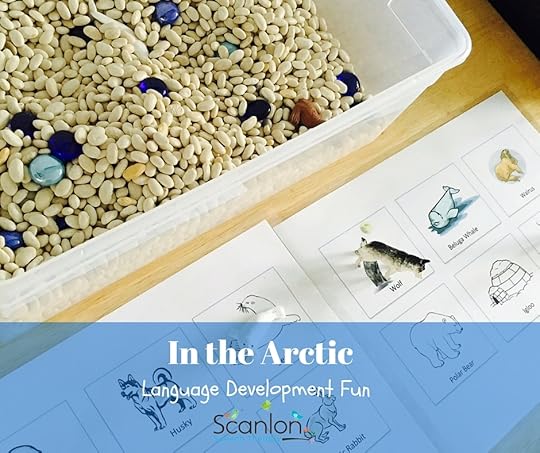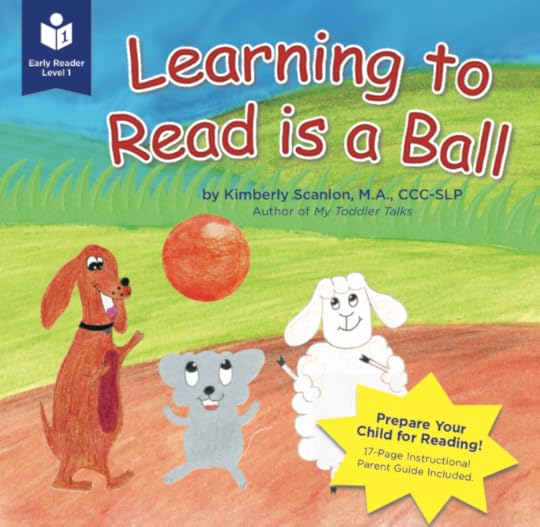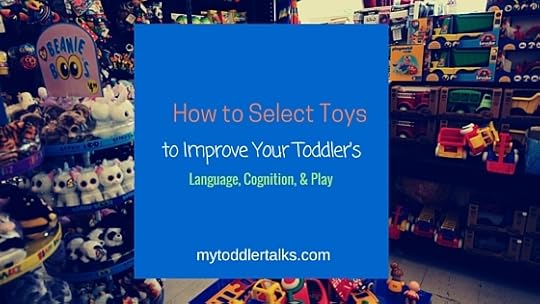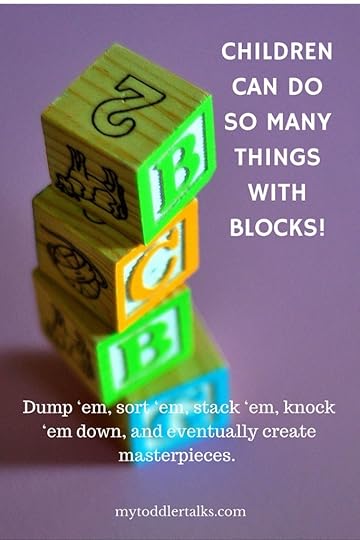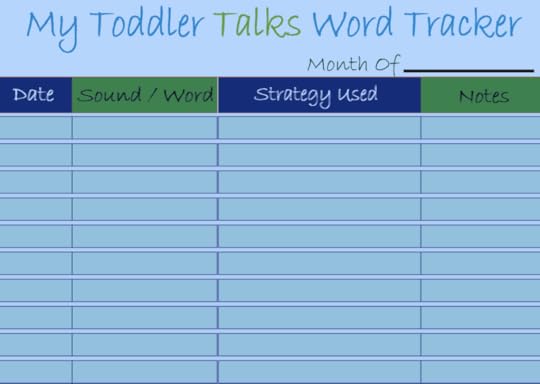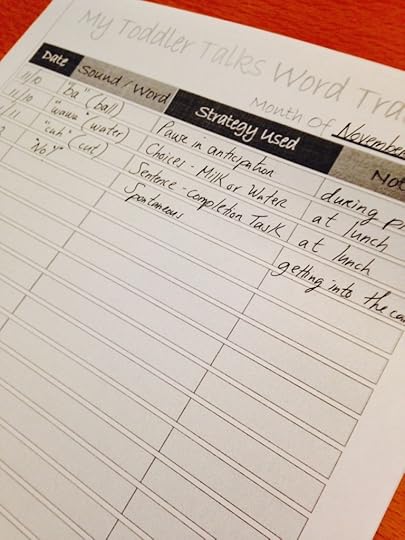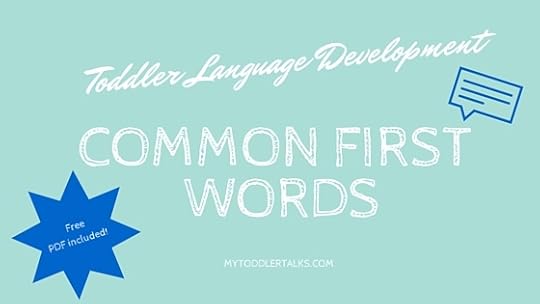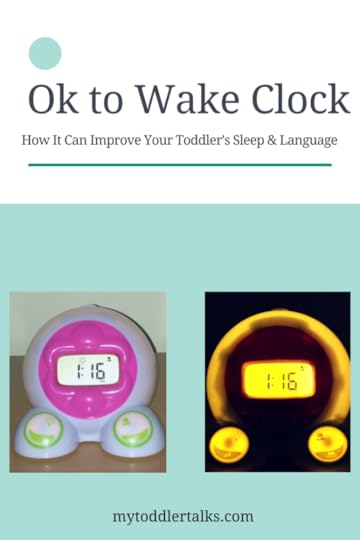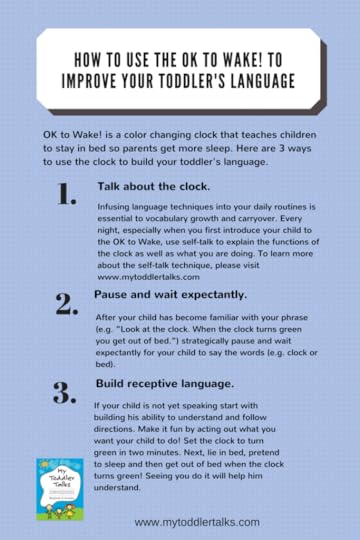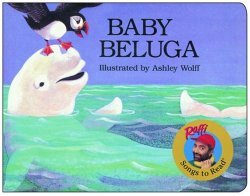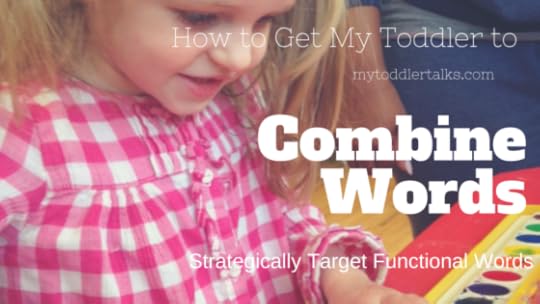Kimberly Scanlon's Blog, page 2
March 31, 2016
Cloze Procedures: How Sentence Completion Tasks Can Get Your Toddler To Talk
Cloze Procedures: How Sentence Completion Tasks Can Get Your Toddler to Talk
A penny for your _______.
Melts in your mouth, not in your _______.
Actions speak louder than _______.
Did you automatically complete the sentences above?
I’m guessing a majority of you did. If you were familiar with these phrases you couldn’t help yourself; your brain automatically filled in the blank.
If you struggled because you don’t eat M&Ms or you’re unfamiliar with these idioms, here are the answers: 1. Thoughts 2. Hands 3. Words
What are Sentence Completion Tasks (or cloze statements or cloze procedures)?
I refer to these as sentence completion tasks but in the speech therapy circle, as well as other education professions, they are known as cloze statements or cloze procedures.
Cloze statements, cloze procedures, or sentence completion tasks are word retrieval tasks that require the participant (child, student, client, etc.) to fill in the blank. The adult says part of the sentence or phrase or verse but intentionally deletes a word, enticing the child to complete it with the correct one. I write about this technique in both of my books, My Toddler Talks: Strategies and Activities to Promote Your Child’s Language Development and Learning to Read is a Ball
and Learning to Read is a Ball .
.
What’s So Great About Sentence Completion Tasks (or cloze statements or cloze procedures?)?
It gives children the opportunity to participate in discussions, book reading, and songs. And, this ultimately increases self-confidence and motivation to speak.
How Can You Use Sentence Completion Tasks (or cloze statements or cloze procedures) to Increase Your Toddler’s Speech and Language?
Now, here’s this best part…sentence completion tasks are simple and fairly straightforward!
Say part of a FAMILIAR sentence, phrase, verse, or song but intentionally delete a word.
Entice your child to fill in the blank by pausing a few seconds and waiting expectantly (Please click the links to read more about those techniques) for a response.
For instance,
Sing:
Row, row, row, your…
Twinkle, twinkle, little…
Or maybe your little one loves the show PAW Patrol? If that’s the case, sing the theme song (because 1. They like it 2. It’s familiar to them 3. They’ll want to complete the phrase!)
PAW Patrol, PAW Patrol, We’ll be there on the ________.”
Or maybe your tyke likes the book Brown Bear, Brown Bear ?
Brown bear, brown bear, What do you _____?
Sentence completion tasks during shared book reading is a fantastic way to increase your child’s language and participation. If you pick up a copy of Learning to Read is a Ball, you’ll see that I’ve underlined the last rhyming word in each verse to help remind you to perform this technique.
Although all children can benefit from sentence completion tasks, they are best suited for children who have stronger comprehension skills and have started speaking his or her first words.
This is because to complete the sentence the child has to dig through some memories, activate prior knowledge, and conjure up the word. This all helps to develop thinking skills. When children begin speaking their first words, they will more easily fill in the missing words.
If a little more support is needed, pair auditory input with visual or tactile input. For example, while reading “Brown bear, brown bear, what do you ______” , point to your eyes while pausing and waiting expectantly for your child to say see.
Additional prompting may include use of phonemic cues (fancy speech therapy term!)
This means you give the first sound or syllable of the target word. For example, while while reading “Brown bear, brown bear, what do you ______” you say the “s” in see.
I’ll end this post by conjuring up memories of an old commercial…
Remember the once very popular mattress commercial:
“Call 1-800 M-A-T-T-R-E – S and leave off the last S for savings?”
Well, in this case, leave off the last word of a FAMILIAR rhyme, song, verse, or routine and entice your child to complete it!
As always, I hope this post was helpful!
Need some more language development tips? Maybe you’ll be interested in these:
7 Ways to Promote Communication Without Frustration
8 Ways to Get Your Toddler to Communicate
If you are in need of some additional free and helpful resources, please subscribe to my newsletter – I share more information exclusively with my newsletter subscribers.
If you have enjoyed reading My Toddler Talks: Strategies and Activities to Promote Your Child’s Language Development please help spread the word about my book. Please tell your friends, write an honest review on Amazon, click the Facebook like button on landing page, or personally give me your feedback. I love hearing from my readers and value their input. You are the reason why I devote so much time to perfecting my craft.
The post Cloze Procedures: How Sentence Completion Tasks Can Get Your Toddler To Talk appeared first on My Toddler Talks.
February 25, 2016
Touch and Explore Sensory Bin – A Sample Play Routine from My Toddler Talks
My Toddler Talks has 25 fun play routines designed to improve your child’s speech and language skills. Many of the play routines involve popular and favorite toys and objects found in most households. This is a benefit for busy parents who can’t or don’t want to run out and purchase more toys as well as for early intervention therapists who are encouraged to use what is already in the child’s environment.
Below is an example of one play routine included in My Toddler Talks: Strategies and Activities to Promote Your Child’s Language:
Enjoy!
Materials:
An empty shoebox or any type of square container
Several bags of dried beans or dried pasta (such as shells, farfalle, and bowtie pasta)
Warning: Do not use beans or dried pasta if your child is still mouthing objects as this may be a choking risk!
Spoons, cups, whisks, and other kitchen utensils with no sharp edges
Small figurines or puzzle pieces (anything that can be hidden under the beans)
Play Routine:
Beginning:
Present the bin filled with the beans and pasta to the toddler. Touch the beans and encourage him to do the same. Watch and see what he does. Many toddlers enjoy touching, digging, and putting their hands under the beans. Allow your toddler time to feel this new texture and experience the sensation. Follow the toddler’s lead and do the same thing that he is doing.
Middle:
Take one of the utensils and use it to move the beans and noodles. Use a spoon to pick up and then dump some beans, and while doing so, talk about what you are doing. Next, give the spoon to the toddler. Watch what he does with it. Take turns using the spoon. Teach turn taking by saying, “It’s my turn…. Now it’s your turn,” or “Now it’s Jack’s turn.” Then, introduce another utensil. Most toddlers find this activity very fun and stimulating. Once all the utensils have been used, hide puzzle pieces or other small toy objects under the beans and pasta, such as shapes from shape sorters or figurines.
End:
End the routine once all the utensils have been used and/or once the toddler has found all the objects. Sing a clean-up song and move on to a different activity.
Language Techniques:
Self-talk and parallel talk: Periodically, narrate your actions and the toddler’s actions: “I’m mixing the beans,” or “You’re touching the beans.” Improvise the type and the length of the utterance based on the toddler’s current language skills.
Pause in anticipation: Pause three to five seconds after making a comment. Give the toddler some time to process the comment and respond. For example, you can say, “I can’t find the ________ (name of hidden object),” or “I don’t see the __________ (name of hidden object).” Then count to five and wait expectantly for the toddler to say something. Most will try locating the hidden object. Accept any response. If there is no response, just keep playing.
Choices: You can ask the toddler what utensil he would like to use for this activity. Take out two items. “Do you want the spoon or the cup?” Say this while displaying the two items.
Other Ideas or Variations:
Use COLD beans! I discovered this neat sensory trick accidentally on a winter’s morning when I left my box of beans in the car overnight – makes for an extra cool sensory experience.
Accept that your toddler may want to stand or sit in the bin. As you can see, this is something I allow! This is a fantastic opportunity to target the early developing preposition in.
Have a preschooler? May want to see my latest post on Scanlon Speech Therapy:
In the Arctic: Language Development Fun
If you are in need of some additional free and helpful resources, please subscribe to my newsletter – I share more information exclusively with my newsletter subscribers.
If you have enjoyed reading My Toddler Talks: Strategies and Activities to Promote Your Child’s Language Development please help spread the word about my book. Please tell your friends, write an honest review on Amazon, click the Facebook like button on landing page, or personally give me your feedback. I love hearing from my readers and value their input. You are the reason why I devote so much time to perfecting my craft.
The post Touch and Explore Sensory Bin – A Sample Play Routine from My Toddler Talks appeared first on My Toddler Talks.
January 7, 2016
My Toddler Talks Best of 2015

“Another year over and a new one just begun…” – John Lennon
Hi Folks!
Happy 2016. Hope you are all well and excited for this upcoming year. I know I am!
Although 2015 wasn’t the amazing year filled with rainbows and lollipops, it was a fine, productive year. I am grateful for my loving family and friends, my dedicated clients, and my encouraging readers. Thank you all for being here.
Bye 2015 and HELLO 2016!
Quick year in review:
I’ve been a busy bee treating clients in my private practice. Seeing clients always makes me happy and provides great insight and inspiration for my writing. Admittedly, though, it’s very hard to research techniques, treat, write, and market when you’re a one-person business.
I published my second book Learning to Read is a Ball.
This interactive picture book about balls includes an extensive, step-by-step parent guide to help parents, early educators, and fellow speech language pathologists, develop oral language, phonological awareness, and print awareness. These skills are the building blocks for future academic success. Researching, illustrating, and writing this book was a great labor of love. In many ways it’s a book ahead of its time. If you would like to learn more about Learning to Read is a Ball, please click here.
Our daughter, our little blessing, continues to melt our hearts and make us smile and laugh while simultaneously turning our hair grey! I was hoping to report news of a rainbow baby but unfortunately I’ve had more loses (total of 4). I’m naturally upbeat and effervescent but recurrent miscarriages (occurring for unknown reasons!) can really take the wind out of one’s sails. Each loss is painful and heartbreaking. It can also be lonely…if you let it be. I’ve slowly learned that maintaining a positive and upbeat attitude is essential. It’s the only thing you can control. You control your attitude. Each day, I say a prayer, get out of bed, and embrace and appreciate everything and everyone I have. I also surround myself with loved ones who lift me up. If you have experienced losses like me, I hope you’re fortunate to have a compassionate and supportive village.
Well, enough about that…
…here’s to 2016!
Here are my top 10 posts of 2015 based on popularity:
Speech Therapy for Toddlers: The Power of Repetition
Before First Words: Using Fun Sounds To Encourage Toddler Communication
How To Get Your Toddler to Combine Words: Part 1 Going Beyond Single Words
How to Get My Toddler to Combine Words: Part 2
Baby Beluga: A Book and Song to Improve Your Toddler’s Language
How to Get My Toddler To Combine Words: Part 3
How the Ok to Wake Clock Can Improve Your Toddler’s Sleep & Language
6 Tips for Selecting Toys to Improve Toddlers’ Language, Cognition, and Play
How to Track My Toddler’s First Words
A peek at what’s to come in 2016:
MORE Videos!! So in 2015 I only created one video for the My Toddler Talks website, but I managed to create 6 videos for Scanlon Speech Therapy. Here they are if you’re interested in taking a look:
Build Vocabulary with Synonyms and Antonyms
How to Make Connections While Reading with Your Child
Vocabulary Development: How to Use a Describer Reading Style
Ocean Themed Summer Books for Language Learning
How to Perform a Fun and Effective Read Aloud
Help My Child to Read Series: Going on a Picture Walk
Even More FREE worksheets and handouts for my newsletter subscribers. I think I did a nice job creating free worksheets and handouts for my readers in 2015. I will continue to bring you helpful handouts and will design them specifically for parents, speech therapists, and educators. If you like them, can you do me a huge favor and share them with your family, friends, and clients?
Lastly, I have been working hard on another project. I’ll share more about it in the upcoming months! Please stay tuned.
I’m hoping that 2016 will be an amazing year for both you and your families, as well as for us!
Interested in reading my top posts from 2014? Please click here.
The post My Toddler Talks Best of 2015 appeared first on My Toddler Talks.
December 4, 2015
6 Tips for Selecting Toys to Improve Toddlers’ Language, Cognition, and Play
What toys will help my toddler talk, learn, problem solve, and play?
With the holidays around the corner, I know many of you are thinking, “I don’t want to waste money and buy just any trendy toy or character piece that my toddler will play with once then disregard.
How can I choose a toy that will get repeated use and build these skills in my toddler?
Well, you’ve come to right place. Amazon affiliate links included. Thank you for your support!
In the past, I’ve shared many toddler toy recommendations:
Speech Therapy Toys for Toddlers
More Speech Therapy Toys for Toddlers
Over at Scanlon Speech Therapy, I’ve also included toy and game recommendations for children in preschool and up.
Speech Therapy Toy Recommendations for Toddlers, Preschoolers, and School Age Children
Select toys that do more than one thing.
If you are on a budget or are embracing a minimalistic approach to toys, I highly recommend toys that can be used multiple times in many different ways.
“Wise parents also think about the number of toys that children are given. While most toy rooms and bedrooms today are filled to the ceiling with toys, intentional parents learn to limit the number of toys that kids have to play with.” – Joshua Becker of becomingminimalist
Nesting and Stacking Blocks are a perfect example. Children can do all sorts of things with blocks. Dump ‘em, sort ‘em, stack ‘em, nest ‘em, knock ‘em down, and eventually create masterpieces.
are a perfect example. Children can do all sorts of things with blocks. Dump ‘em, sort ‘em, stack ‘em, nest ‘em, knock ‘em down, and eventually create masterpieces.
If you’re on a budget, refrain from purchasing too many toys that only do one thing. A toy that only lights up when you turn it on is bound to become boring because it doesn’t encourage the child to do anything else with it. Children will bore quickly if the toy doesn’t…
Foster exploration and curiosity.
Toddlers are hands-on explorers who are driven by impulse and curiosity. As a result they touch and manipulate EVERYTHING because doing so fires those synapses. When selecting a toy, ask yourself:
“Will this toy stimulate my child’s curiosity and sense of exploration?”
In my experience, toys that require manipulation to produce a result (e.g. Jack in The Box or a large spinning top
or a large spinning top ) or create change (e.g. Y happens after X like B. Whacky Ball
) or create change (e.g. Y happens after X like B. Whacky Ball ), or have multiple parts (e.g. Mr. Potato Head
), or have multiple parts (e.g. Mr. Potato Head and shape sorters
and shape sorters ) will propel that sense of exploration and curiosity.
) will propel that sense of exploration and curiosity.
Are intrinsically motivating and interesting.
Toys that are intrinsically motivating build a child’s confidence, competence, and determination to persist and keep trying. Internal rewards that come from within trump any external rewards such as stickers or candy. Games, toys, and play routines that follow a toddler’s lead and interests have a greater likelihood of being intrinsically motivating and interesting. Questions to ask:
“Will figuring out the steps in the toy release dopamine and provide internal motivation to keep playing?” and “Will this toy appeal to his interests and likes?”
Please click the image below to download a free PDF to help you select an appropriate toy for the special child in your life.

FREE PDF FOR MY TODDLER TALKS READERS.
Promote independence
Let’s face it, your child loves playing with you but there are times you need to get things done or just have a cup of coffee in peace (is that even possible?)
Select a few toys or activities your toddler can play with somewhat independently without too much assistance from you.
When deciding on a toy, ask yourself:
“How much support will my child need to understand and play with this toy?”
Puzzles, doodle pads , and Window Clings
, and Window Clings are good examples. Large serving spoons, utensils, kitchen Tupperware, empty cardboard boxes, or a collection of empty paper rolls are also fun!
are good examples. Large serving spoons, utensils, kitchen Tupperware, empty cardboard boxes, or a collection of empty paper rolls are also fun!
Why not wrap some random FREE, household objects and put them under your tree?
Opening the gifts are half the fun anyway!
Increase socialization and pretend play
“When children are playing pretend they are playing ‘as if’ something or someone is real. They are creating a situation where there is more going on that what is literally happening. For example, a child might be placing a cup to the doll’s mouth and then lying the doll in a bed ‐ but to the child, the doll is alive and really drinking (and it might even burp) and when the doll is put in the bed, the doll is really sleeping – and so the child will have to wait until the doll wakes up.” – Dr. Karen Stagnitti of Children Need to Play
Depending on your child’s skills and developmental level, it’s also wise to purchase some toys that enhance make believe, promote role playing, and develop sequential thinking. Large dollhouses , Jumbo Cardboard Blocks,
, Jumbo Cardboard Blocks,  and Kitchen Sets
and Kitchen Sets are toys that will assist in developing these skills.
are toys that will assist in developing these skills.
Ever wonder why public sandboxes, swing sets, slides, and playgrounds are so popular with young children? The larger the play items the better chance other children will want to join in play!
Relate to on a personal level
I have met many toddlers that really like playing with my car wash set . The children who enjoy this set the most are those who know what a car wash is and or have gone to one. The point is, children want to play with toys that make sense to their life experience and recreate or extend those events.
. The children who enjoy this set the most are those who know what a car wash is and or have gone to one. The point is, children want to play with toys that make sense to their life experience and recreate or extend those events.
A child who has never been to a car wash may not understand a miniature car wash play set, even if you explain it to him. He needs to have an experience to compare it to.
3 More Things to Consider:
Durability
Toddlers are strong and sometimes clumsy. Pass on the iPad, even if it’s in a great case, and select toys that can survive being dropped, crushed, stepped on and pulled apart.
Affordability
Don’t feel pressured to buy toys or gifts that you can’t afford.
“If I can’t afford to replace it, I shouldn’t buy it.”- Kimberly Scanlon
Safety
If your child is still putting everything in his mouth, read the labels and find out where the toys are manufactured. Stay away from toys that contain magnets and are brightly colored as they may contain lead paint.
Check out the Consumer Product Safety Commission for the latest recalls.
I hope this list has been helpful!!
If you are in need of some additional free and helpful resources, please subscribe to my newsletter – I share more information and worksheets with my newsletter subscribers.
If you have enjoyed reading My Toddler Talks: Strategies and Activities to Promote Your Child’s Language Development please help spread the word about my book. Please tell your friends, write an honest review on Amazon, click the Facebook like button on landing page, or personally give me your feedback. I love hearing from my readers and value their input. You are the reason why I devote so much time to perfecting my craft.
The post 6 Tips for Selecting Toys to Improve Toddlers’ Language, Cognition, and Play appeared first on My Toddler Talks.
November 12, 2015
Speech Therapy: How to Track My Toddler’s First Words
Speech Therapy: How to Track My Toddler’s First Words
Are you the lucky parent of a delightful toddler?
Or, the fortunate speech language pathologist or professional who works with charming, adorable toddlers?
If so, I bet you’ve heard or asked this question a bunch:
“How many words does your child say?”
Maybe you’ve heard it at your pediatrician’s office.
Maybe you’ve heard it from friends or even complete strangers (e.g. the nice cashier at the grocery store or a mom at the playground).
Or, maybe you’ve read announcements on your Facebook feed from proud parents revealing that their brilliant child who is only 15 months old has 50 words and speaks in full sentences. Maybe you even unfollowed your dear friend after reading it? I kid, I kid. Of course you wouldn’t do that, right?
I often encourage my clients to track their child’s first words.
Why Should I Track My Toddler’s First Words?
Tracking toddler’s first words tells us a few things.
1. Quantity – It tells us how many words are in a child’s expressive vocabulary.
By this I mean, the words that he or she can say independently, spontaneously – all by him or herself. For instance, Willie says milk every time he wants milk and doesn’t need to be prompted to say it.
Please know – just because your child doesn’t or can’t say a word doesn’t mean he doesn’t understand it. In other words, your child’s ability to understand words (receptive language) usually exceeds his or her ability to say a variety of words (expressive language). For instance, I still fumble over the word “Worcestershire” and avoid saying it whenever possible. But, boy oh boy, I certainly know what it is because I like Worcestershire sauce on my broiled salmon. Toddlers are similar. Some avoid saying words because they are hard to articulate OR because they’re not entirely sure or confident when or how to use the word (this is why you need to repeat, repeat, repeat).
2. Quality – It tells us the types of words a child can say.
Folks, stop scrolling, this is important.
What types of words does your child say?
Does your child use any social or action words to express a need, want, or affection? Or, is it primarily nouns (names of people, places, or things)?
Please check out my post titled Common First Words: Speech Therapy and see the categories of words to give you some perspective.
The child who can name every car brand, train, or extinct dinosaur may have lots of nouns in his expressive vocabulary. But, how is he using these words? Is he rattling them off in a rote fashion and not using them to comment or request?
A child excitedly shouting and pointing to “T-Rex!” while looking at mom is conveying – Mom, you have to look at this cool dinosaur. I demand your attention and shared joy, NOW!)
A child who says, “T-Rex” with a rising intonation while putting it into your shopping cart is clearly requesting that you buy T-Rex.
3. Rate of progress – It tells us how many words have been added over a time period.
Toddlers with typically developing language add new words on a daily basis. How else would they go from having 2 to 6 words (other than mama and dada) to 1,000 words by 3 years old?
If you’re tracking his or her words, you’re more inclined to notice the pace of his vocabulary growth.
In closing…
Click here for a free copy of my word tracker sheet – if there are ANY ways I can improve it, please shoot me an email at kim@scanlonspeech.com.
I’ll conclude this piece with 4 rules nuggets of wisdom recommendations:
See the columns titled Strategy Used and Notes? Track the words that your toddler says both spontaneously AND when a strategy is used.Here’s an example:
Remember – first words are words that he or she says spontaneously, with no support or prompting. Many children who are starting to add words to his or her repertoire will often imitate words before spontaneously saying them. And, children with a language delay will need strategies to help them acquire first words. Thus, use the strategies in *My Toddler Talks: Strategies and Activities to Promote Your Child’s Language Development
 to help! (Subscribe to my newsletter to receive the Cheat Sheet too). Amazon affiliate link included.
to help! (Subscribe to my newsletter to receive the Cheat Sheet too). Amazon affiliate link included.Toddlers aren’t expected to say articulate words 100% correctly. Not until the age of 4 years old are children expected to be 100% intelligible. Even then, they may still mispronounce words. Click here to read, “Is Your Child Intelligible?”
What’s that? You want to know if you can track word combinations? Sure, but good luck keeping up with it! Maybe I’ll write a post on that another time.
Lastly, keep your sanity. Try tracking the words for a week or two. If it seems like a needless, painstaking task, then maybe it’s not for you. If it makes you stressed, then don’t do it.
As always I hope this has been helpful!
A few years ago, I designed the The Word Tracker App to assist in the process. I’ll be redesigning this app very, very soon so feel free to give me any feedback – I’ll take the good, the bad, and the ugly (kim@scanlonspeech.com).
If you are in need of some additional free and helpful resources, please subscribe to my newsletter – I share more information exclusively with my newsletter subscribers.
If you have enjoyed reading My Toddler Talks: Strategies and Activities to Promote Your Child’s Language Development please help spread the word about my book. Please tell your friends, write an honest review on Amazon, click the Facebook like button on landing page, or personally give me your feedback. I love hearing from my readers and value their input. You are the reason why I devote so much time to perfecting my craft.
The post Speech Therapy: How to Track My Toddler’s First Words appeared first on My Toddler Talks.
September 21, 2015
Common First Words: Toddler Speech Therapy
Common First Words: Toddler Speech Therapy
The following is a list of common first words adapted from The Rossetti Infant Toddler Language Scale (2006) and from the research findings of Professor Leslie Altman Rescorla, the director of the Child Study Intitute at Bryn Mawr College. Her results indicate that there are 25 commonly used words that toddlers know, even those that are slow to learn language. This suggests that these words are worth targeting when working on language intervention for late talkers.
If your child is not yet using some of these words, try targeting a few when participating in the play routines presented in My Toddler Talks: Strategies and Activities to Promote Your Child’s Language Development. (Amazon affiliate link included.)
Click the image to download a free PDF for your own erudition.
If you are a speech language pathologist or educator, please feel free to make copies to share with your families. If you think there is anyway I can improve this handout, please let me know: kim@scanlonspeech.com
I hope this has been helpful.
If you are in need of some additional free and helpful resources, please subscribe to my newsletter – I share more information exclusively with my newsletter subscribers.
If you have enjoyed reading My Toddler Talks: Strategies and Activities to Promote Your Child’s Language Development please help spread the word about my book. Please tell your friends, write an honest review on Amazon, click the Facebook like button on landing page, or personally give me your feedback. I love hearing from my readers and value their input. You are the reason why I devote so much time to perfecting my craft.
The post Common First Words: Toddler Speech Therapy appeared first on My Toddler Talks.
August 17, 2015
How the Ok to Wake! Improves Your Toddler’s Sleep & Language
How the Ok to Wake! Clock Can Improve Your Toddler’s Sleep and Language Skills
I’m about to share something that may potentially change your life.
Okay. That might be an overstatement.
A few months ago a former client made a wonderful recommendation that revolutionized my sleep, my husband’s, and my daughter’s.
In the past, I have shared how our lovely daughter was a TERRIBLE sleeper for the first 2 years of her life as she had severe reflux. We NEVER slept. Seriously. We were up constantly throughout the night and when we finally had some shuteye, our little precious would be raring to go as early as 4:00 in the morning (early rising is common in young ones with reflux).
Now, we always usually sleep in…to about 6:30am…for you lucky folks who are blessed to have a child sleep peacefully until 8:00, consider yourselves very, very fortunate. I couldn’t imagine!
If you have a child who is an early riser and happily bounces out of bed, ready to PLAY, please allow me to introduce you to the children’s alarm clock, OK to Wake! Children’s Alarm Clock and Nightlight .
.
 Amazon affiliate links are included for your convenience.
Amazon affiliate links are included for your convenience.
The following description of Ok to Wake! is straight from Amazon. My notes are italicized and intermingled between:
OK to Wake, color changing night-light timer teaches children to stay in bed longer in the morning so parents get more sleep
The clock turns green when it’s okay to get out of bed. If the child wakes up and the clock is not green, he or she is to stay in bed.
Customizable: Parents set the OK to Wake, time and brightness
Very easy to program.
Separate “Nap Timer” allows for afternoon napping without disrupting usual alarm and night-light settings
I have not used it for napping but I’m sure it works well too.
Alarm clock with snooze function allows older kids to get up “on their own”
Ha! I wish my Kerri would hit snooze…perhaps when she’s in highschool!
Fun “toe” buttons designed for kids invoke funny facial animations on the LCD
Ummm…no, we don’t allow Kerri to touch it in fear that she will remove the batteries.
Why am I writing about the Ok to Wake Clock?
For two reasons:
Many toddlers, especially those with delays and disorders, are not good sleepers. Accordingly:
“..a population-based study of parent reported sleep problems in preschool children with ASD (Autism Spectrum Disorder), developmental delay without ASD and typical development, parents in all three groups reported very high rates of sleep concerns. Approximately half of the parents of children with ASD and children with developmental delay reported at least one sleep difficulty, while one-third of the parents of children with typical development had similar concerns.” -Krakowiak et al.
When your child doesn’t sleep, you don’t sleep. If no one is sleeping, then everyone is cranky. Thus, I’m sharing about the Ok to Wake Clock because it may help you and your child get a little more sleep.
I have prepared 3 ways to use the Ok to Wake Clock to improve your toddler’s language.
Three Ways to Use the OK to Wake! to Improve Your Toddler’s Language:
1. Talk about the clock as part of your child’s nightly routine.
Infusing language techniques into your daily routines is essential to vocabulary growth and carryover. Every night, especially when you first introduce your child to the OK to Wake, use self-talk to explain the functions of the clock as well as your own actions. Click here to learn more about the self-talk technique.
For instance: “Look at the clock. When the clock turns green you get out of bed.”
Try to use the same or similar phrase each evening so your child remembers hearing it and begins to anticipate it.
Color association – Using the Okay to Wake clock may also increase your child’s ability to understand colors because the color green has meaning (green means okay to wake, go, or get out of bed).
2. Use pauses and waiting expectantly to elicit language.
After your child has become familiar with your phrase (e.g. “Look at the clock. When the clock turns green you get out of bed”) strategically pause and wait expectantly for certain choice words (e.g. clock or bed).
For instance, if your phrase is “Look at the clock.” Before saying “clock”, pause…and then wait expectantly for your child to say the word “clock”.
3. Build receptive language.
As I mention on page 4 of My Toddler Talks: Strategies and Activities to Promote Your Child’s Language Development :
:
…”a language delayed child or a late talker may first become responsive to communication bids before initiating dialogue. For instance, the toddler may follow directions (e.g. “Stop it” or “Come here”), identify pictures, or even use gestures or motions before saying words or verbalizing his intentions.”
If your child is not yet speaking start with building his ability to understand and follow directions.
Please click the image below (or click here) to download a PDF of How to Use The Ok to Wake to Improve Your Toddler’s Language.
Make it fun by acting out what you want your child to do! Set the clock to turn green in two minutes. Remember while setting the clock, say the familiar phrase “I’m setting the clock.” Next lie in bed pretend to sleep (snore and make other fun sounds) and then get out of bed when the clock turns green!
Caveat: Ok to Wake will probably work best with children who have some symbolic thought, meaning they will understand that the colors have meaning (e.g. green means go or wake up and red means stop or stay in bed).
For more tips on sleeping check out -Dr. Craig Canapari’s post titled – Early Morning Awakenings: What to Do About Them.
Note: There are several other versions of this clock put out by Patch Products but I only have this one so I can’t vouch for the others…if YOU or someone you know has another version, please comment below to share your feedback…yay or neigh…why or why not?
I hope this post has been helpful to you!
If you are in need of some additional free and helpful resources, please subscribe to my newsletter – I share more information exclusively with my newsletter subscribers.
If you have enjoyed reading My Toddler Talks: Strategies and Activities to Promote Your Child’s Language Development please help spread the word about my book. Please tell your friends, write an honest review on Amazon, click the Facebook like button on landing page, or personally give me your feedback. I love hearing from my readers and value their input. You are the reason why I devote so much time to perfecting my craft.
please help spread the word about my book. Please tell your friends, write an honest review on Amazon, click the Facebook like button on landing page, or personally give me your feedback. I love hearing from my readers and value their input. You are the reason why I devote so much time to perfecting my craft.
References:
Sleep problems in children with autism spectrum disorders, developmental delays, and typical development: a population-based study
Paula Krakowiak, M.S.,1,2 Beth Goodlin-Jones, Ph.D.,2,3 Irva Hertz-Picciotto, Ph.D.,1,2 Lisa A. Croen, Ph.D.,4 and Robin L. Hansen, M.D.2,5
The post How the Ok to Wake! Improves Your Toddler’s Sleep & Language appeared first on My Toddler Talks.
July 7, 2015
Baby Beluga: A Book and Song to Improve Your Toddler’s Language
Any Raffi fans here? If you were born in the 1970s, 1980s, or 1990s, you may be familiar with the singer-song writer Raffi. He is well known for writing and singing many popular children’s songs. If you’re not familiar with Raffi, don’t worry. I too was unfamiliar with his music despite being born during one of those decades and still managed to have a very fine childhood. (Now I just ponder, what if?)
Baby Beluga: A Book & Song to Improve Your Toddler’s Language
*Amazon Affiliate links have been included for your convenience.
Luckily though, a former client of my mine introduced me to Raffi so now I have the opportunity to pass on his classics to my daughter and current clients.
For the past several weeks, I’ve had one of Raffi’s songs stuck in my head. It’s a happy song about a baby whale (aka a beluga) who travels the wide blue ocean with his mother.
Here is Raffi singing Baby Beluga:
I can’t help but smile when I hear Baby Beluga on repeat (in my head) or hear my daughter singing it.
So, why all this talk about Raffi and my earworm?
If you have a toddler and want to build his or her speech and language skills, I highly suggest incorporating music into his or her daily routines.
Music helps with language acquisition because it teaches children about language structure as well as beat and rhythm.
According to Sally Goddard Blythe, author of The Genius of Natural Childhood: Secrets of Thriving Children,  “Neuro-imaging has shown that music involves more than just centralized hotspots in the brain, occupying large swathes on both sides.” Therefore, music uses and develops more sides of the brain. During the first few years of life it’s very important to develop as much of your child’s brain as possible.
“Neuro-imaging has shown that music involves more than just centralized hotspots in the brain, occupying large swathes on both sides.” Therefore, music uses and develops more sides of the brain. During the first few years of life it’s very important to develop as much of your child’s brain as possible.
If you’re looking for some new music, try introducing your child to the sweet song Baby Beluga!
I particularly like this song for toddlers because
it contains many instances of the early developing bilabial sound “b”
has repetition and rhythm
is relatively slow but still playful
is easy to decipher the spoken words.
After you have introduced the song to your child and have discovered him or her humming or singing the tune, then read Baby Beluga (Raffi Songs to Read) , a cute and simple book, to bring the song to life!
, a cute and simple book, to bring the song to life!
Language Development Tips:
For toddlers just beginning to make sounds and talk – focus on having your child attempt the repeated refrain:
“Baby beluga, oh baby beluga”
Start by singing the first part of the refrain together (“Baby beluga oh baby ) and then pause ________ and have your child say the second part (“…beluga”). Or, strategically pause to have your child say “oh”.
For toddlers starting to combine words –
Take turns describing what you and your child see on each page. Use the carrier phrase, “I see a _______” or “This is a ______”. This will provide opportunities to expand on your child’s short phrases to complete longer, fuller sentences.
I hope your child enjoys Raffi’s playful song and adorable book, as much as my own!
Enjoy your summer and remember to wear sunscreen.
For more summer reading suggestions, please see:
A Toddler Summer Book to Build Language: At the Beach
Your child may also enjoy these books:
5 Summer Books for Preschool Language Development
as well as these:
As always, I hope this has been helpful.
In need of some additional free and helpful resources? Please subscribe to my newsletter. I share information and handouts exclusively with my newsletter subscribers.
If you have enjoyed reading My Toddler Talks: Strategies and Activities to Promote Your Child’s Language Development or Learning to Read is a Ball
or Learning to Read is a Ball please help spread the word. Tell your friends, write an honest review on Amazon, click the social media buttons or personally give me your feedback. I love hearing from my readers and value your input.*Amazon Affiliate links included for your convenience. Thanks for reading!
please help spread the word. Tell your friends, write an honest review on Amazon, click the social media buttons or personally give me your feedback. I love hearing from my readers and value your input.*Amazon Affiliate links included for your convenience. Thanks for reading!
References:
Hill, A. (2011, May 8). Singing to children may help development of language skills. Retrieved from http://www.theguardian.com
The post Baby Beluga: A Book and Song to Improve Your Toddler’s Language appeared first on My Toddler Talks.
A Summer Song and Book to Improve Your Toddler’s Language: Baby Beluga
Any Raffi fans here? If you were born in the 1970s, 1980s, or 1990s, you may be familiar with the singer-song writer Raffi. He is well known for writing and singing many popular children’s songs. If you’re not familiar with Raffi, don’t worry. I too was unfamiliar with his music despite being born during one of those decades and still managed to have a very fine childhood. (Now I just ponder, what if?)
*Amazon Affiliate links have been included for your convenience.
Luckily though, a former client of my mine introduced me to Raffi so now I have the opportunity to pass on his classics to my daughter and current clients.
For the past several weeks, I’ve had one of Raffi’s songs stuck in my head. It’s a happy song about a baby whale (aka a beluga) who travels the wide blue ocean with his mother.
Here is Raffi singing Baby Beluga:
I can’t help but smile when I hear Baby Beluga on repeat (in my head) or hear my daughter singing it.
So, why all this talk about Raffi and my earworm?
If you have a toddler and want to build his or her speech and language skills, I highly suggest incorporating music into his or her daily routines.
Music helps with language acquisition because it teaches children about language structure as well as beat and rhythm.
According to Sally Goddard Blythe, author of The Genius of Natural Childhood: Secrets of Thriving Children,  “Neuro-imaging has shown that music involves more than just centralized hotspots in the brain, occupying large swathes on both sides.” Therefore, music uses and develops more sides of the brain. During the first few years of life it’s very important to develop as much of your child’s brain as possible.
“Neuro-imaging has shown that music involves more than just centralized hotspots in the brain, occupying large swathes on both sides.” Therefore, music uses and develops more sides of the brain. During the first few years of life it’s very important to develop as much of your child’s brain as possible.
If you’re looking for some new music, try introducing your child to the sweet song Baby Beluga!
I particularly like this song for toddlers because
it contains many instances of the early developing bilabial sound “b”
has repetition and rhythm
is relatively slow but still playful
is easy to decipher the spoken words.
After you have introduced the song to your child and have discovered him or her humming or singing the tune, then read Baby Beluga (Raffi Songs to Read) , a cute and simple book, to bring the song to life!
, a cute and simple book, to bring the song to life!
Language Development Tips:
For toddlers just beginning to make sounds and talk – focus on having your child attempt the repeated refrain:
“Baby beluga, oh baby beluga”
Start by singing the first part of the refrain together (“Baby beluga oh baby ) and then pause ________ and have your child say the second part (“…beluga”). Or, strategically pause to have your child say “oh”.
For toddlers starting to combine words –
Take turns describing what you and your child see on each page. Use the carrier phrase, “I see a _______” or “This is a ______”. This will provide opportunities to expand on your child’s short phrases to complete longer, fuller sentences.
I hope your child enjoys Raffi’s playful song and adorable book, as much as my own!
Enjoy your summer and remember to wear sunscreen.
For more summer reading suggestions, please see:
A Toddler Summer Book to Build Language: At the Beach
Your child may also enjoy these books:
5 Summer Books for Preschool Language Development
as well as these:
As always, I hope this has been helpful.
In need of some additional free and helpful resources? Please subscribe to my newsletter. I share information and handouts exclusively with my newsletter subscribers.
If you have enjoyed reading My Toddler Talks: Strategies and Activities to Promote Your Child’s Language Development or Learning to Read is a Ball
or Learning to Read is a Ball please help spread the word. Tell your friends, write an honest review on Amazon, click the social media buttons or personally give me your feedback. I love hearing from my readers and value your input.*Amazon Affiliate links included for your convenience. Thanks for reading!
please help spread the word. Tell your friends, write an honest review on Amazon, click the social media buttons or personally give me your feedback. I love hearing from my readers and value your input.*Amazon Affiliate links included for your convenience. Thanks for reading!
References:
Hill, A. (2011, May 8). Singing to children may help development of language skills. Retrieved from http://www.theguardian.com
The post A Summer Song and Book to Improve Your Toddler’s Language: Baby Beluga appeared first on My Toddler Talks.
June 1, 2015
How to Get My Toddler to Combine Words: Part 3
How to Get My Toddler to Combine Words: Part 3
If you have a toddler and are trying to move him or her from single words to word combinations and phrases, please read my previous two posts titled, How to Get My Toddler to Combine Words: Part 1 and How to Get My Toddler to Combine Words: Part 2 .
In this post, allow me to further elaborate on how you can encourage word combinations by strategically expanding those single word utterances.
Are you ready?
Toddlers’ initial word combinations are not entirely random. In fact, many toddlers like to talk about the same things. These favorite types of words tend to emerge before other words for reasons related to cognitive development, basic needs and wants, personal preferences, and social, cultural mores. But, here’s the thing – these favorite words can be used to help your toddler combine multiple words together.
For our purposes, let’s refer to this list as FAVORITE TODDLER WORDS. Here they are:
1. Names of things, people, and places (especially things, people, and places that are special and important)
Special people (e.g. Mommy, daddy)
Special things (e.g. favorite doll or stuffed animal)
Special places (e.g. home, park, grandma’s house)
2. Actions (especially funny and unexpected ones)
What people are doing (e.g. “Daddy eat’”)
What things receive an action (e.g. “Anna fell” – think of the beginning of Frozen.)
3. Locations of things and people and where an action takes place
Where people and things are located (e.g. “Mommy here”)
Where an action took place (e.g. “in crib”)
4. Differences of opinions or preferences
When they don’t want to do something (e.g. “No!”)
When they disagree (e.g. “No!”)
When they want to deny or reject anything you say (e.g. “No!”)
5. Possessions (especially personal ones)
When something belongs to them, NOT you (e.g. “My” or “mine”)
When something belongs to someone else that they know (e.g “Mommy’s shirt” or “Daddy’s sock”)
6. Amusing words and sounds
May include words like: “Stinky”, “poop”, “boo”, “tickle, tickle”, “messy”, or “roar”. For more funny sounds, read Using Fun Sounds to Encourage Toddler Communication
7. Simple social words
Many toddlers are encouraged to say “Hi” and “Bye” because parents train them at young age to be friendly and nice.
Strategically bombard your child with specific words from the FAVORITE TODDLER WORDS to help him or her communicate essential needs, wants, and desires.
Tack on words from the FAVORITE TODDLER WORDS list to the single words that he or she is already consistently and regularly saying.
For instance if your child says, “doggie” every time you go for a walk (perhaps your neighbor has a dog and you see it on every walk?), expand on it by saying, “Hi , doggie” or “Bye, doggie” every time you see a dog. Having him say “Hi, doggie” or “Bye, doggie” is a nice way to encourage word combinations via simple social words (FAVORITE TODDLER WORDS #7). Since he already has “doggie” in his expressive repertoire and you’re interested in having him greet family and friends with a simple hi, you could model “Hi, doggie”, etc.
Or, if you want to encourage word combinations via the location of things (FAVORITE TODDLER WORDS #3) every time you help dress your child use the same phrases like, “Shirt on”, “Pants on”, or “Shoes on”. This will clearly teach your child that his shirt is on his body, his pants are on his legs, and his shoes are on his feet.
Eventually, you saying a particular phrase, like “Hi, doggie”, “Bye, doggie”, “Shirt on”, “Pants on”, will become part of the routine and your child will internalize it and eventually attempt to say it too.
These are just two examples of how to strategically bombard your child with some FAVORITE TODDLER WORDS. It’s your job (or your amazing speech therapist’s) to figure out which types of words from the FAVORITE TODDLER WORDS will help your child communicate most effectively and efficiently.
One last thing before I go – expect them to imitate your word combinations after hearing them several times. Then, one day soon you will be pleasantly surprised to hear them say the word combinations when you least expect it!
As always, I hope this has been helpful.
In need of some additional free and helpful resources? Please subscribe to my newsletter. I share information and handouts exclusively with my newsletter subscribers.
If you have enjoyed reading My Toddler Talks: Strategies and Activities to Promote Your Child’s Language Development or Learning to Read is a Ball
or Learning to Read is a Ball , please help spread the word. Tell your friends, write an honest review on Amazon, click the social media buttons or personally give me your feedback. I love hearing from my readers and value your input.*Amazon Affiliate links included for your convenience. Thanks for reading!
, please help spread the word. Tell your friends, write an honest review on Amazon, click the social media buttons or personally give me your feedback. I love hearing from my readers and value your input.*Amazon Affiliate links included for your convenience. Thanks for reading!
The post How to Get My Toddler to Combine Words: Part 3 appeared first on My Toddler Talks.

